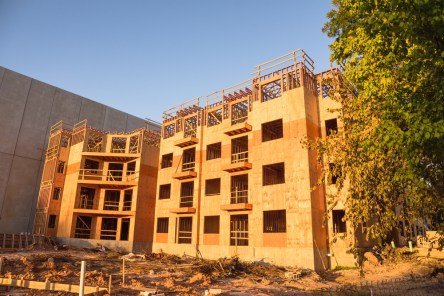The impact of remote work on the housing market has been significant. In a webinar by Yardi Matrix, Jeff Adler, Matrix vice president, brought up several notable shifts. The full recording and presentation slides are available online. Let’s explore the big-picture impact of remote work on housing and communities. There are myriad cultural changes from the pandemic from an economic standpoint, but one of the most significant transitions is the prevalence of remote work. Working remotely offers more opportunities for household formation. In addition, with remote working becoming more prevalent, some employees are no longer tied to living near the offices. This has increased interest, particularly in suburban areas like Charlotte and Phoenix, where households can enjoy more space, lower living costs and a quieter lifestyle than in urban centers. Additionally, some businesses have chosen to leave high-cost cities for lower-cost ones, such as San Francisco to Austin, New York to the Carolinas and Chicago to Nashville. “I think Huntsville is a great market for many businesses, but it’s just now beginning to have a lot of supply hit,” said Adler. “Any place where you got to have a supply response will run through some struggles for the next couple of years as it gets absorbed.” In addition, research found that remote work has led to a surge in household formation, counterbalancing population loss in dense cities. First-time homebuyers are becoming priced out of the market, which encourages renting, especially while mortgage rates are at the highest level in more than 13 years. Household formation could stall as renters move in with family or roommates to cut costs. Remote work has given homeowners and renters more flexibility in choosing where to live. This has resulted in shifts in migration patterns. People are moving from...
Multifamily Outlook
Positive Expectations
The national outlook for the multifamily sector remains positive through the end of 2022, with asking rent performance expected to have increased by around eight percent by year’s end. That’s according to the latest U.S. Multifamily Outlook report released today by Yardi® Matrix, a leading provider of data and analysis on most real estate verticals. The report examines the state of the economy, including ongoing inflation and recession concerns, but concludes that though rent growth is slowing down, gains are expected to continue. Average national asking rents increased 5.7 percent in the first six months of the year. Year-over-year rent growth at the year’s midpoint was 13.7 percent, down 100 basis points from the end of 2021 and 150 basis points from the February peak of 15.2 percent. “While growth is moderating, we expect gains will continue to remain well above trend, with average asking rents increasing by 7.9 percent nationally by the end of 2022,” states the forecast. However, the increases are far from 2021’s record 14.7 percent increase. Property fundamentals continue to be exceptional, with demand driven by robust household formation, job growth, migration to suburbs and secondary markets, and the inaffordability of single-family homes for many would-be buyers. More than 900,000 new multifamily units are under construction nationally, with 420,000 expected to be delivered this year. Gain more insights about expectations for the remaining months of 2022 in the latest Matrix Multifamily Outlook. Yardi Matrix offers the industry’s most comprehensive market intelligence tool for investment professionals, equity investors, lenders and property managers who underwrite and manage investments in commercial real estate. Yardi Matrix covers multifamily, student housing, industrial, office and self storage property types. Email [email protected], call (480) 663-1149 or visit yardimatrix.com to learn...
Renters Still on the Move
Matrix Multifamily Webinar
With the future of office-based employment still in flux for millions of Americans, the multifamily industry continues to see dramatic shifts in where renters are living, as well as rent increases that have yet to be fully factored into the nation’s inflation calculations. Summer and early fall of 2021 saw dramatic increases in multifamily asking rents, a growth trend that Yardi Matrix vice president Jeff Adler called “a barnburner” in this week’s webinar analyzing the sector’s recent performance. However, rent growth is expected to temper in the final months of 2021. “We have really seen a shifting and reallocation of population due to remote work,” Adler stated. “This is the American people solving a (housing) supply problem in the most expensive areas. They are now able to take their paycheck with them and move to less expensive areas.” View the presentation and find slides on yardimatrix.com. At the outset of the presentation, Adler encouraged multifamily investors to develop a strategy that considers the future of office-based employment. Instead of workers going back to the office in droves this fall, the summer Delta variant surge delayed and, in some cases, derailed office reopenings. Some jobs, like financial and government roles, require onsite security and can’t be done remotely. The technology industry is expected to lead fully remote and hybrid opportunities. “Work is now not somewhere you go, but something you do,” Adler said. That ongoing transformation will continue to play out over the next two years. “It’s not going to go back to the way it was, and neither are offices going to be irrelevant.” Economy still in transition phase Meanwhile, the U.S. economy has been struggling to recover from the pandemic. Supply chain issues as well as reduced employment, especially among Americans age 55 and up, are prompting widespread inflation issues that seem likely to persist for the near-term. Yardi Matrix has revised its inflation outlook since the last multifamily webinar was held, Adler noted. And one indicator that inflation may get worse before it gets better is that rent increases are a trailing indicator and have yet to make their way into Consumer Price Index (CPI) calculations. “The Fed (Federal Reserve) story has been that inflation is transitory, but it’s not looking that way to us as an organization,” Adler stated. He noted that had the projections of transitory inflation been accurate, they should have been resolving right about now. Instead, inflation continues to rise. “There is a lot of dry powder in terms of consumer spending. This is a case of too much money facing too few available goods,” Adler explained. Available cash has helped fuel consumer purchases (buoying industrial real estate) and relocations (increased rents in multifamily and high demand for self storage.) “Everything you used to know about inflation has been upended,” Adler said. “I think we will see recovery in services inflation, but an expansion of (cost of) goods inflation. And we haven’t seen the increased rent impacts flow through inflation metrics yet.” High demand for tech hub housing + single family rentals High demand for coveted housing markets, especially in tech hubs like Austin, Denver, Las Vegas, Nashville, Orlando, Phoenix, Raleigh-Durham and Seattle, has driven prices up and availability down in those cities. Meanwhile development is returning and Matrix has revised its anticipated unit delivery target from 350,000 multifamily units per year to 400,000. An especially hot subset of the multifamily market is single family homes that are build-to-rent (BTR), which are driving increase suburbanization of the rental space. Some renters are turning to the BTR option because heightened home prices have put down payments out of reach. BTR homes currently make up 5-10 percent of new home stock, according to the U.S. Census Bureau. And they’re expected to grow dramatically, with $30-40 billion in capital currently designated for the BTR space, Adler said. However, don’t assume that it’s families with kids trading...
Materials Volatility
Churns Construction Industry
Why have housing prices risen so dramatically lately? The answer begins with a huge uptick in demand driven by rising housing starts – seasonally adjusted single family housing starts in December 2020 hit their highest level since 2006 – along with low mortgage interest rates. An equally crucial factor is the rising cost of materials used to build and renovate homes. Structural steel, copper wire and other metal items – prices for all these products have risen substantially because of new housing, locked-down homeowners with time and money to spare for renovations, shut-down factories and lumber mills and tariffs. A sharp upturn in copper prices is “adding tens of thousands of dollars to a half-a-million-dollar” commercial project, according to Ben Goldberg of Petaluma, Calif.-based Simply Solar California. Perhaps the most volatile element is the market for lumber, used for framing, roofs, decks and fencing. In June, lumber costs were up 340% from 2020 levels before dropping dramatically a few weeks later, as sawmills ramped up production and imports increased. By early July, although still well above pre-pandemic levels, prices per board feet of lumber had dropped to 49% of its all-time high on May 28. Prices for other wood products were up 500% from pre-pandemic levels by mid-July, while the cost of steel mill products, up by about 70% in the first few months of 2021, remains high. The National Assn. of Home Builders, an industry advocacy group, estimated in May that the lumber price spike added nearly $12,000 to the market value of an average newly built multifamily home. Some wood products executives see the recent demand surge as a return to normal rather than abnormally high. Housing starts averaged 1.5 million units per year from 1960 through 2010 but lagged far below...
Rents Rise Nationwide...
New report from Yardi Matrix
Multifamily asking rents jumped an average of 6.3% year-over-year in June, the largest leap ever recorded by Yardi Matrix, a leading industry data tracker. The national average apartment rent increased $23 last month to $1,482, another record, and single-family home rents were up 11% year-over-year. “These are the largest year-over-year and monthly increases in the history of our data set,” said Jeff Adler, vice president of Yardi Matrix. Analysts point to increased household savings and government stimulus funding as factors that have kept the multifamily industry stable during the pandemic period, and now able to rebound as the economy improves. The newly released data is an economic indicator of post-pandemic recovery across the U.S. The largest increases were documented in the lifestyle apartment sector. Renters are also now returning to many gateway markets that saw outbound migration for most of the last year. A supercharged housing market is also pricing out some potential buyers, leading residents to remain in apartments. “Rent growth will not be able to continue at these levels indefinitely, but conditions for above-average growth are likely to persist for months,” Adler said. The increases reflect growth in what landlords are asking for unleased apartments. Renters renewing leases may also be seeing increased rents, but likely at lower levels. Migration is pushing up rents in Southwest and Southeast metros like Phoenix (17.0%), Tampa and California’s Inland Empire (both 15.1%), Las Vegas (14.6%) and Atlanta (13.3%). These metros were lower cost compared to larger gateway metros. Get more insight on the historic report. Yardi Matrix offers the industry’s most comprehensive market intelligence tool for investment professionals, equity investors, lenders and property managers who underwrite and manage investments in commercial real estate. Yardi Matrix covers multifamily, student housing, industrial, office and self storage property...
Recovery Gains
National Multifamily Report
As the U.S. economy continues to show recovery gains, multifamily housing follows suite. Several factors including prevalent industries, vaccination rates and employment create a distinction between markets with rapid growth and lagging gains. Need-to-know data, quick and easy Multifamily rents increased by 2.5% year-over-year (YoY) in May. This nearly reflects rent growth rates of March 2020, before the development of pandemic trends. For the second consecutive month, all top 30 metros showed positive month-over-month (MoM) rent growth. An impressive 90% had MoM gains of 0.5% or more.Rents grew $12 in May to $1,428. That’s the largest one-month increase in Matrix history. The 0.8% MoM growth rate was the largest since June 2015.Rents increased nationally by 0.8% in May. Of our top 30 metros, 22 demonstrated positive YoY rent growth this month. Run, walk, and crawl: metros demonstrate growth at different rates Some rents grow at a sprint. YoY rent growth reached double digits in the Inland Empire for the first time in recorded history. Rent growth in the Inland Empire clocked in at 10.2% followed by at Phoenix 9.6% and Sacramento at 8.3%. Gateway markets have found a comfortable stride. Miami reports a respectable 6.0% growth, the strongest in the region. Others are crawling or have yet to budge, though all signs point to improvements soon. Chicago with 0.0% growth and Los Angeles at -0.1% are still better positioned than San Jose (-9.0%), New York (-8.8%) and San Francisco (-6.7%). Introducing single family rental data Matrix reporting now includes single-family rents within built-to-rent communities. Data is compiled from more than 90,000 units in 700 communities nationwide. Single-family rentals (SFR) thrived during the pandemic. The industry recorded a powerful 7.3% YoY rent growth as of May. This reflects an overall rent increase of about $14...
Fashion Retailers
Fit for a Rebound?
Stay-at-home orders, occupancy limitations and business closure orders during the pandemic took a big toll on fashion merchants. Renowned retail brands such as Neiman Marcus Group, J. Crew Group Inc., Brooks Brothers, Ascena Retail Group (operator of Ann Taylor, Lane Bryant and others) all filed for bankruptcy protection last year as sales plummeted 86% in the first months of the pandemic. Others, like LVMH Moët Hennessy Louis Vuitton, Macy’s, H&M and Burberry, closed outlets or trimmed payroll amid drastic sales slumps. The Washington Post reported in April that nearly 200 U.S. department stores have disappeared in the past year alone, with another 800, about half the country’s remaining mall-based locations, potentially being shuttered by the end of 2025. While U.S. consumers shelled out $192 billion more for online purchases in 2020 than they did a year earlier, online clothing sales rose far less than did food and beverages, consumer electronics, personal care and home furnishings. In February, U.S. spending at clothing and accessories stores was down 11% from a year earlier, according to the Commerce Department; overall retail sales grew 6.3% in that period. Purchasing perks up One reason for depressed store sales, of course, is e-commerce. Mark Cohen, director of retail studies at Columbia Business School and former chief executive of Sears Canada, notes, “The customer who used to be handcuffed to their local department store is no longer tethered because they have an online alternative that’s become even more attractive in the last year.” But things could be looking up for retail. The U.S. Commerce Department reported that overall retail spending rebounded sharply in March, rising 9.8% after the dip in February. Department store sales rose 13% from a month earlier, boosted by stimulus checks and pent-up demand. “What we’re seeing emerging...
Surviving + Thriving
Self Storage Sector Stays Resilient
During every Yardi Matrix webinar, vice president and presenter Jeff Adler shares the big picture of current economic conditions and conundrums – also known as the Yardi Matrix House View. Here’s how the view is looking from the Matrix vantage point these days: “We had a deep recession. We’re in the middle of a recovery. That recovery is likely to be choppy,” summarized Adler to close out Thursday’s Matrix update on the self storage sector. A recording of the presentation is now available, and you can view that here. But for those invested or interested in the self storage market, the seas are not looking quite so rough. Of all commercial real estate sectors, storage had a brief negative impact from COVID-19’s rise in the U.S., and then quickly recovered. “Storage is actually doing quite well,” said Chris Nebenzahl, editorial director for Yardi Matrix. “The demand for storage has been consistent and is stronger than some of the other asset classes in commercial real estate.” Key factors for the sector’s resiliency include: Relocations and population migration. Americans are leaving congested big cities like New York and Los Angeles for second-tier markets where they have more space. Residential volatility. For example, college students have faced ever-changing mandates about whether they would resume classes in person and online, prompting quick moves that often involve a need for storage. Economic hardship. Job losses for millions of Americans are contributing to relocations and downsizing. According to a Pew Research Center Survey, roughly one in five U.S. adults say they have either changed their residence due to the pandemic or know someone who did. The proof of sustained demand for storage is in the street rates, particularly for the non-climate-controlled category. Month-over-month rates reported for August showed that national...
Sublease Space to Spare?
Commercial Vacancy High in Major Metros
Commercial real estate has encountered a space problem: there is too much of it. Unused, unwanted square footage is having a ripple effect throughout the industry, stalling new deals and prompting tenants to get creative with their leases. Which markets have the most excess space? Tech markets such as San Francisco and Boston are among the cities with the most space to spare. The report suggests that tech companies often lease more space than they need. If they are hit with a sudden need to expand, the resources are readily available. Conversely, they are apt to offload unneeded space during economic downturns such as this one. Markets with a broader range of employment sectors recorded more modest increases in available space. Dallas-Fort Worth, Manhattan, and Washington, D.C. are among the top markets with a moderate increase in excess space scattered across its large providers of health care, tech and energy services. “We believe that the second quarter was the low point for the market with office leasing activity down by more than 40 percent from a year earlier – and that we’ll begin to see a gradual recovery,” says Ian Anderson, CBRE’s Americas Head of Office Research in an interview with World Property Journal. Huston was the only market with negative space to lease between March and June 2020. The city recorded a -2% change for a total of 5.2 million sq. ft. How is the excess space impacting the commercial market? Though the national vacancy rate increased 10 basis points to 13.2%, listing rates remain comparable to figures recorded at this point last year. Average full-service equivalent listing rates only fell by 0.7% to $38.15 per square foot in May. Analysts suggest that the demand for new office space has declined to such a point that traditional price reductions would not produce the desired effect. Additionally, multi-year office leases make substantial price decreases unfeasible. It also seems that many office owners are still optimistic for a V-shaped recovery, counting on pre-COVID-19 levels by Q4. While listing rates seem stable, the excess office space has had a notable effect on future demand. Per the Yardi Matrix Office National Report, the second quarter recorded only $4.4 billion in transactions compared to $12.7 billion at this point last year. Buildings near completion are still slated for delivery. New supply, however, is being added at a pace slower than seen at this point in 2019. The total amount of planned office space decreased by 8.5%. Due to the current downturn, analysts expect deliveries to continue at a slower pace than last year. Get the complete Yardi Matrix Office National Report Subletting office space provides some relief to lessors The recession, high vacancies rates and low demand have left tens of millions of square feet on the negotiation tables. To add to the excess, the average company requires about 20% less space now than it did pre-COVID 19. The market has plenty of space to spare, and tenants are seeking creative ways to make the most of unused square footage. Per a recent report by global property consultant CBRE, the 10 largest U.S. office markets experienced a 12% increase in space offered for sublease. Since March, the major markets offered 6.1 million additional square feet of space to bring the current total to 59 million. Lessors seek to sublet to recuperate costs on unused space. Per Tenant CS, which offers conflict-free tenant representation services, tenants can expect to recover less than 50% of their rent obligation. During the current economic downturn, that cushion may be the difference between making rent or not. Nearly half of commercial retails rents were not paid in April and May, for example. Figures are better for office tenants. Currently, REIT-owned office buildings report that they are collecting about 90% of rents from tenants. The concern, however, is that employers will embrace remote work for good. Some will make...
Relocations + Rent Drops
COVID-19 Prompts Migration
Already apparent in the U.S., COVID-19 has resulted in a migration from major cities and falling rents. As the housing industry braces itself against continued impacts from the virus, will both trends continue into the third quarter? Market analysts, real estate agents and renter surveys give us clues about what to expect. Are people really moving away from cities as a result of COVID-19? Yes. People are leaving cities to avoid COVID-19 risks and disturbances. Though it is a misconception that population density equates to higher risk, perception matters. The perceived increase in risk has made city residents feel less safe. That fear, coupled with other disruptions, motivates relocation for those who can afford it. Pew Research Center reports that 3% of U.S. adults moved due to the pandemic and about 6% had a member of their household relocate. Of those surveyed, 28% moved to reduce their risk of contracting the virus and 8% moved due to job loss. About 20% moved to be closer to family. Younger people make up a unique portion of those who relocated. Roughly 9% of adults ages 18-29 relocated due to the virus. This includes 23% of respondents who were university students forced to vacate their campuses. Even New York– the market trendsetter that has captured hearts for generations– is seeing mass movements to the nearby suburbs. Real estate agents Susan Horowitz and Monica Schwerberg explored the details in an interview with NPR. “We are seeing 20 offers on houses. We are seeing things going 30% over the asking price. It’s kind of insane,” Horowitz said. “It is a blood sport.” She adds, “Every last bit of it is COVID-related.” Schwerberg agrees, “In the month of April, where we typically would get maybe 75 inquiries in a month, we had over 400 inquiries.” People who once loved the city atmosphere are seeking locations with less population density, which is falsely assumed to correlate with increased infection risks. Additionally, many breadwinners are now working from home. Remote work opportunities have made commute times less of a factor in housing decisions. Since March 2020, about 10,000 New Yorkers filed for address changes to the state of Connecticut alone, reports Hearst Connecticut Media. Nationwide, U.S. Postal Service data indicates that southern Florida and southern California are popular relocation destinations. Who is moving during COVID-19? While some people are relocating due to job loss and financial difficulty, there is a correlation between job security, higher incomes and relocation. In short, households with higher incomes can afford to sell their current home (potentially at a loss) or terminate a lease early in favor of getting a new home in the suburbs. Higher income households are also more likely to have remote work. The ability to maintain income while working from anywhere permits the flexibility needed to relocate during the pandemic. Additionally, higher income households represent the demographic most likely to own a vacation home. About 13% of those who relocated moved into their second home or vacation home, reports the Pew survey. How does COVID-19 relocation impact the rental market? Yardi Matrix analyzed asset performance data from 107 major metropolitan areas between April and May 2020. During that time, multifamily rents declined by .4% nationwide. Overall, twice as many markets witnessed rents decline than rents rise. “Multifamily’s nearly decade long run of healthy performance increases came to an abrupt and unexpected end this year,” said Jeff Adler, vice president of Yardi Matrix. “Job losses have been particularly high among apartment renters, and simply collecting rents and maintaining occupancy is a new area of focus for owners and managers.” The report suggests that the pandemic’s influence on work conditions, public health metrics and social trends will continue to impact the housing marketing for the next several years. “If renters decide to eschew urban apartments for a more distanced standard of life in the suburbs or smaller cities, multifamily could...
Long Term Impacts
New Yardi Matrix Report
With the U.S. economy in a recession, unemployment numbers sky high and COVID-19 cases surging in the south and west, multifamily owners and operators face challenging times ahead. And things may get worse before they get better, according to a new special report from Yardi Matrix. The report is based on a study of 107 major metros, with data reflecting April and May 2020 asset performance. Over that period, multifamily asking rents dropped .4% nationally, and twice as many markets saw rents decline as opposed to increase. Renters are looking for less expensive units, with the biggest impacts in the sector felt by Class A+ properties. Rents for “luxury lifestyle” properties dropped by -1.2% over the last two months, compared to a decline of .5% for “renter by necessity” properties. “Multifamily’s nearly decade long run of healthy performance increases came to an abrupt and unexpected end this year,” said Jeff Adler, vice president of Yardi Matrix. “Job losses have been particularly high among apartment renters, and simply collecting rents and maintaining occupancy is a new area of focus for owners and managers.” Multifamily had a long run of strong performance – asking rents grew by 26% nationally between January 2015 and 1Q20. But going forward, the future looks cloudy at best. “The shape of the recovery remains unclear. More importantly, the pandemic is spurring changes in working conditions and social trends that will impact housing demand for years to come,” states the report. What’s ahead will be determined by a complicated combination of economic factors, public health metrics and renters’ feelings about the future. If renters decide to eschew urban apartments for a more distanced standard of life in the suburbs or smaller cities, multifamily could be in for a prolonged pain period. Gain...
Rents Drop, Prompting Concern
Industry insight from Yardi Matrix
When you think about a 0.3 percent drop in anything it hardly seems like a big deal. It’s just 3 pennies on every 10 dollars. If you are an apartment operator and that reflects the national average on rents for May compared to April, some would figure it’s something not too difficult to make up. But what if it isn’t? The three-tenths of a percent is the drop for one month, and 12x that comes to 3.6 percent annually. Quickly, that could become serious. During what would typically be the middle of prime leasing season, rents declined nationally by 0.3% on a month-over-month basis, reports Jeff Adler, vice president of Yardi Matrix. He describes that drop in rents as startling. “Is it a harbinger of things to come? A warning sign?” Adler says. “When rents being offered to new residents drop like that month-over-month, year-over-year you have to ask yourself.” Adler says current national multifamily occupancy rates are mostly steady (a good thing). And there’s no deterioration in demand as measured by apartment search activity, which is also positive. “But this is peak leasing season,” he adds. “Falling like this would be at a rather significant clip. If we see it again next month, then demand will not have stabilized. And data show this is happening to high-end apartment communities.” The steepest declines in rents on a MoM basis were seen in major gateway markets that were among the first to impose strict lockdowns. Smaller markets are not immune and have seen substantial MoM rent declines as well. For this “general rolldown” in rents, Yardi Matrix has observed year-over-year price decreases of -0.6 percent to -1 percent for houses for rent in Los Angeles, San Jose, Houston, Orlando, Denver, San Francisco and Chicago. Unprecedented Swiftness Many long-standing observers and employees of the multifamily industry can point to real estate’s cycles, and to the Great Depression, back around 2008-09, when rent declines were similar. “But the swiftness of what we’re seeing now is unprecedented,” Adler says. “Back then, job formations were slowing and you could almost read between the lines to know something bad was coming up. There were signals. This time, it’s sudden. This time it’s being caused by a health issue. We are counting on a vaccine or treatment to COVID-19 to turn the tide.” Job creation, of course, is helpful. Job losses, however, equate to income losses and ability to pay the rent, and inability for owners to stabilize (if not raise) rents. “For the sake of the industry, let’s hope that six months down the road things are different,” Adler says. “Wouldn’t it be great to go back to how it was in February, or even in 2019?” Some can speculate that the “busy season” for leasing could move to fall this year. Look at These Numbers Yardi Matrix also reports that national average rents decreased $5 to $1,460. Kansas City (0.4 percent), San Antonio and Baltimore (both 0.1 percent) were the only markets to show increases from April to May; 23 markets remain negative on a month-over-month basis. the last two months overall, rents have declined by $13. “If rents continue this rapid downward trend, we could be looking at alarming numbers by the end of the summer,” Adler says. The markets with the most severe MoM declines include Houston and San Jose (both -0.9 percent) and Nashville, Orange County and Seattle (all -0.8 percent). Houston tends to be among the most volatile markets in a normal month, and given the rapid decline in oil prices the road to recovery in Houston could be extended. San Jose, Orange County and Seattle were among the first markets to impose stringent lockdowns. Seattle only entered Phase 1 of reopening on June 5. Social Unrest Could Affect Urban Rents Apartment operators also must consider the social unrest that is going on in many urban centers. “What’s going on right now...
Reshoring Jobs
Benefits for U.S. workers, real estate
A thriving job market is great for commercial real estate, especially when it demands industrial sites. After decades in China, several American-owned manufacturers are bringing their jobs back to American soil. Property developers and owners in a few unlikely areas are benefiting from reshoring efforts. Why the Switch? The American skilled labor workforce has always had its appeal. That skills, however, sometimes came at a cost that seemed prohibitive to many manufacturers. Times are changing. Manufacturers are discovering that automation may help them experience significant savings on labor costs. Automated plants, staffed by a small group of highly qualified tech professionals, can cost less than foreign factories with thousands of laborers. A growing number of companies are finding that the costs of manufacturing—coupled with transportation and distribution expenses—don’t offer the savings that they once did. Tray Anderson, lead of logistics and industrial services in the Americas for Cushman & Wakefield, suggests that reverse logistics are a key factor in reshoring decisions. “Typically, we see an appetite for reshoring if there is an eight to 12 percent difference in overall costs [compared to manufacturing products outside the U.S.],” said Anderson. That margin has decreased when manufacturers consider capital investment, labor costs, logistics, storage, depreciation, operations, and product returns as well as losses from product obsolescence that occurs when shipping products between continents, he says. Then there are the tariffs. A poll issued by the American Chamber of Commerce and its partner in Shanghai reveals the impact of recent tax. This year, about 40 percent of respondents state that they “are considering or have relocated manufacturing facilities outside of China.” Comparatively, the 2018 survey stated that only 30 percent of manufacturers had considered “partial relocation.” America has further sweetened the pot for companies with local and...
Downturn Ready?
Tips from NAA Maximize
At Maximize powered by NAA, the annual conference dedicated to asset and revenue management and long-term value creation for apartment portfolios, industry pros talked about how changes in the economy — including an expected downturn ahead — will impact multifamily revenue management. This year’s sessions covered renovations and amenities in some detail, with panelists speaking about the importance of flexible strategies when navigating changing markets. For example, there might be less demand than anticipated for high-end renovations. Conversations also turned to smart home technology including self-showing programs, and short-term rentals as a new revenue stream that would be increasingly compelling in struggling rental markets. While some attendees have only known growth, experienced revenue managers who maneuvered through the last recession shared tactics and valuable lessons learned. Although it’s unclear exactly when the next downturn will happen, the consensus at Maximize was it will happen. And the sooner you’re ready for it, the better. Curveballs ahead So how do you prepare for a downturn? Experts agree that having a well-informed revenue management strategy in place is crucial, and that means having tools to collect data to uncover trends and follow patterns in order to make smart decisions. Beyond finding the sweet spot for rental pricing, auditing your properties for other ways to boost performance is also a great idea — including assessing amenities and reducing unnecessary expenses. In addition to knowing how to price units based on inventory and market conditions, the most effective revenue managers also know every selling point of each property in their portfolio. With the advent of artificial intelligence and machine learning to guide asset management, sometimes the computer knows what’s happening before people do. In times of both growth and recession, the most successful revenue managers will be using a...
Migration Matters
New Matrix Research
U.S. migration from domestic and international sources continues to hold profound implications for the country’s economy and demographic composition. It’s also the subject of a new research report from Yardi Matrix. The report notes that the South, Southwest and West accounted for 80% of the population growth in the country’s top 50 metros between 1970 and 2018. “Migration is a leading factor in the population shift” and is “being driven by a combination of economic, social and technological factors” including lower costs of living and doing business, tax policies, land availability, climate, and cultural and recreation attractions. “Technology makes both individuals and corporations more mobile than before, and as the economy grows, more service-oriented businesses are less tied to physical locations,” says the report, which was published in PREA Quarterly, a members-only publication for the real estate investment community. Older core metros that lost populations to domestic outmigration are still holding their own. For example, New York City, Miami, Los Angeles, Washington, D.C., and Boston are top destinations for international migrants who fill jobs and fuel economic growth. “Immigration has been the ace in the hole for primary commercial real estate markets” by compensating for domestic outmigration and declining birth rates among native-born women, the report says. Business, finance and technology opportunities in the cities referenced above, and others such as San Francisco, also are magnets for young, educated workers. New Work and Lifestyle Options Along with the policies, social forces and economic trends shaping migration patterns, the report addresses factors affecting the real estate industry such as housing affordability, homeownership and family formation. “Investors must pay attention to developments in lifestyle and technology,” such as exercise rooms, shared space, better food options and other amenities that workers increasingly expect. On the residential side,...
Self Storage Update
High Supply a Mixed Blessing
Will too much of a good thing hurt the U.S. self storage industry? Possibly, but elevated supply is just one uncertainty surrounding the sector, which was the subject of a recent update presented by Yardi Matrix. Those who invest, manage and develop self storage properties have some positive economic data on their side, such as solid gross domestic product growth, low inflation and rising wages. In another encouraging sign, capital for self storage investment has become abundant as major commercial real estate firms seek to diversify their portfolios. While nationwide delivery of new supply in 2019 will trail last year’s total, growth will “taper off but not fall off a cliff” over the next few years and robust expansion remains the rule, according to Jeff Adler, Yardi Matrix vice president and general manager, who presented the update with Chris Nebenzahl, institutional research manager. Less favorable indicators include the inverted yield curve, international trade conflicts and slowing economic growth in Europe and China. These are among the key factors that elevate the risk of a U.S. recession occurring by mid-2021, Adler said. Key Trends Demand drivers for self storage properties mirror the country’s larger job, population and domestic migration trends: People and employers are leaving gateway markets like New York City, Chicago and Los Angeles for metros in the Southeast and Southwest with lower business and living costs, plus secondary tech markets. That movement has put self storage space in high demand in metros like Dallas, Orlando, Fla., Phoenix, Las Vegas and Charlotte, N.C. These trends shape a short-term need for self storage space, but absorption of existing supply and projects in the pipeline will eventually depress street rates in most markets, with popular millennial destinations like Charleston, S.C., Nashville, Tenn., Denver, Seattle, Orlando and...
Recession-Proof Properties...
Get Strategies at Maximize
As we head into uncertain economic times, is your multifamily portfolio recession proof? Now more than ever, you need data you can trust and a smart revenue management strategy to set competitive rental prices, maximize occupancy and spend marketing dollars wisely. And, with the arrival of artificial intelligence and machine learning to inform business intelligence, computers understand what is happening in the market before people do. In a July 2019 Forbes article, “Three Ways to Recession-Proof Multifamily Properties,” the author stated “Just as ‘all politics is local,’ so is real estate. In their Beige Book, the Federal Reserve governors said real estate activity is declining in some regions even as others pick up the pace. Much of that activity centers on multifamily real estate: 319,000 apartments are due for completion this year nationwide, which the Wall Street Journal determined is the most new units in about three decades. Local conditions should dictate new multifamily purchases and impact investors’ efforts to recession-proof already-owned properties.” Come for Answers So, how do you drive property performance in a changing industry? Join us at Maximize 2019 for some great answers — NAA’s premier event taking place on September 23-24 in Atlanta. This year’s conference will focus on the intersection of asset and revenue management and will deliver knowledge and tactics that attendees can put into action. Educational sessions include the must-attend “Revenue Management and the Recession” on September 24 at 10:00 a.m., moderated by Dhar Sawh, industry principal of revenue management at Yardi. Sawh will be joined by panelists Trey Lane, vice president of pricing and revenue management at Progress Residential, Michael Lilly, director of revenue management at Weidner Property Management and Jessica Mills, senior consultant at D2 Demand Solutions. Attendees will discover what experienced pricing managers learned during the last recession and...
Multifamily Market
Looking Good For Now
While the U.S. multifamily sector basks in a period of extraordinary growth and vibrancy, owners, investors and residents alike should remain on guard against potential headwinds. This was a key message in a recent state of the industry webinar presentation by Jeff Adler, vice president of Yardi Matrix, with assistance from Jack Kern, director of research and publications. Adler repeated many of the macroeconomic themes in his and Kern’s recent U.S. office industry update: The economy is in good shape, the labor market is tight, wages are rising, the Treasury yield curve remains flat and high American oil production is taming inflation. In addition, demographic and lifestyle factors such as divorces that produce new renters, young people marrying later in life and an older population living longer, healthier lives, are fueling a demand for multifamily housing that could exceed 425,000 units annually. Job formation and in-migration to favorable markets will continue fueling this demand for the foreseeable future. While this environment is favorable for absorbing current supply, housing production isn’t likely to keep up with future demand, especially in locations with anti-growth and rent control policies. A worrisome potential outcome is “pain on the affordability side that becomes a danger to the industry,” Adler said. Although homeownership costs are rising faster than renting, the median asking rent has exceeded the inflation rate since 2012. The cumulative weight of those increases is now bearing down on median-income residents in urban locations. Moreover, metros such as San Francisco, Portland, Ore. and New York City drive rents up by constricting new supply, then apply rent control to shield residents from the impact. This approach backfires, making housing even more scarce and unaffordable and prompting outmigration, Adler said. These factors and high taxes have resulted in New York...
Originations Wane
Market Analysis
Editor’s note: Paul Fiorilla is director of research for Yardi Matrix. His analysis of waning loan originations, despite high demand for apartments and industrial real estate, was recently published by Globe Street. You can find the full report summary available for download here. (Select the national category.) Concerns about rising interest rates and weakening economic growth have led to a slowdown in commercial mortgage originations, particularly in out-of-favor asset types, despite the wide availability of debt capital. The Mortgage Bankers Association reported that commercial mortgage originations in 3Q18 fell 7 percent from the same quarter a year ago. The biggest drop came from CMBS, which fell 53 percent year-over-year, and commercial banks, which originated 22 percent less than a year ago, according to the MBA’s survey. Life companies and the GSE multifamily lenders posted slight increases in lending. The decline in lending is more a reflection of demand than supply. No major source of debt capital is pulling back, and the number of debt opportunity funds is on the rise. However, property sales have dipped about 10 percent nationally, while rising interest rates are discouraging some borrowers from refinancing. Since bottoming at just over 2.0 percent in September 2017, the 10-year Treasury has increased steadily and has been over 3.0 percent since mid-September. That has increased loan coupons, although loan spreads have generally come down 40 to 50 basis points over the past year, so the cost of borrowing has not risen as much as interest rates. Tightening loan spreads reflect the healthy appetite among lenders to book loans. Another headwind to originations is the decline in property sales as buyers start to pull back. Sellers are getting fewer bids and – while acquisition yields aren’t yet climbing appreciably – buyers are seeking to...
Industrial Strength
Matrix Market Report
Yardi Matrix took a close look at the U.S. industrial real estate market’s performance in the first half of 2018 and found plenty of positive signs. Indications of the sector’s strength include: Strong demand for space driven by year-over-year e-commerce sales growth of 15.4% Nearly 125 million square feet of industrial space coming online 7% year-over-year rent growth A national vacancy rate below 5% in the first quarter, the lowest since 2010 Commercial real estate-leading investment volume “Demand is stronger than ever” in every industrial subsector, the report says, with warehousing, manufacturing and flex space accounting for most of the occupancy gains. Demand was strongest in California’s Inland Empire, followed by Chicago and New Jersey. The industrial sector continued to benefit from rising e-commerce sales, which totaled $120.4 billion in the second quarter alone and drove the need for distribution centers near dense population areas. Over 90% of the first half’s new supply was warehouse and distribution space, with more than 238 million square feet of additional space under construction at mid-year. In markets where available land for development is scarce, developers focused on renovation and site remediation projects, expecting to recover costs with higher rents. Industrial rents continued to increase in most markets, spurred by the exceptional demand and lack of excess space in the top logistics markets. Rents averaged $6.29 per square foot at mid-year, up 7% year-over-year. “Expect rents to further increase through 2018 as the quality of available inventory improves due to upgrades and addition of new space,” the report says, noting that a slight deceleration might follow in 2019 as projects now under construction add to available inventory. The national industrial vacancy rate, 4.9% in the first quarter, was largely due to companies snapping up space before it was...
Multifamily Update
From Yardi Matrix
Jeff Adler, vice president of Yardi Matrix, assisted by Jack Kern, director of research and publications, recently delivered a webinar on the state of the multifamily industry. Excerpts follow. Q: How is the U.S. economy overall? A: It’s in good shape. Gross domestic product and employment are steady, wages are rising and the labor market is tight. Inflation is rising but under control. Q: And the multifamily market? A: It’s good too, although there are a few crosswinds. Jobs and population growth are strong but shifting to lower-cost cities, and homeownership is gradually rising. Multifamily capital is abundant, and new supply deliveries are weighing down on several markets, with the level of new supply flattening but not declining. Q: Has multifamily supply leveled out, and why? A: Construction delays and financing are a factor. Construction is just catching up to household formation, and builders are focusing on higher-price single family homes. Q: What are some policy changes addressing affordability? A: There are some proposed and implemented government mandates. Other market-oriented changes include a community in Kissimmee, Fla., that encourages residents to cover some of their rent by sharing their apartment on Airbnb; “rent by bedroom” communities that combine private bedrooms with shared kitchen and living areas. The coworking trend offers a model for coliving. Societal infrastructure, especially education, is the power of local economy, which drives multifamily investment. Q: What job growth trends are affecting multifamily? A: Companies are relocating and expanding in lower-cost markets—places like Phoenix, Orlando, Fla., Houston, Las Vegas and Raleigh, N.C. Tech hubs are emerging both in formerly non-tech metros and traditionally overlooked cities, such as Indianapolis, Pittsburgh and Philadelphia. Q: What are some of the other factors in play? A: The 2017 tax reform that caps the deduction for...
Self Storage Update
From Yardi Matrix
The self storage industry has been strong over the last several years, with economic growth creating new households and driving demand. Can this pace continue or will the recent supply surge outpace demand? That question formed the basis of a recent web presentation by Jeff Adler and David Dent, vice president and senior real estate market analyst, respectively, for Yardi Matrix. Their discussion focused on four areas: Macroeconomic Outlook The U.S. economy is in very good shape, Adler and Dent reported, with gross domestic product growing, inflation under control, and a tight labor market “pulling people off the sidelines,” although trade and immigration policies could brake the growth. Their research reveals that millennials and Baby Boomers are leaving big cities such as New York, Los Angeles, Chicago and Miami in favor of smaller, lower-cost cities with concentrations of intellectual capital work, which in turn drives storage demand. Destination metros include Dallas-Fort Worth, Tampa, Fla., Atlanta and Charlotte, N.C., along with retirement favorites such as Las Vegas and smaller mountain metros in the Appalachians and the Rockies. However, rental market fundamentals are faltering, with only 12 of 133 markets studied by Yardi Matrix showing year-over-year rent increases in September 2018, versus as many as 41 in previous years. Profile of Current Supply and Demand Domestic migration patterns have made Las Vegas, Tampa, Phoenix, Orlando. Fla., and Columbus, Ohio, the most attractive metros for self storage providers, Adler and Dent reported. The national average of self storage projects under construction and planned as a percent of existing inventory is 9.5%. Portland, Ore., Nashville, Tenn., Orlando, Boston and Seattle have the highest percentages. Approximately half of storage customers are in the process of moving while the other half are long-term users. Adler and Dent noted that approximately...
Office Update
From Yardi Matrix
A strong U.S. economy has given rise to an equally robust office real estate market. Office-using employment and wage gains outpace the national average growth rate, according to a recent report from Jeff Adler and Jack Kern, vice president and director of research, respectively, for Yardi Matrix. Their update, presented in a webinar, focused on the macroeconomic outlook, national office fundamentals and trends, and technology disruptors. Employment, gross domestic product, household formation and income levels are in good shape, supporting growth in the office market segment. More than half of the 115 major markets surveyed by Yardi Matrix are experiencing moderate rent growth. Intellectual capital—companies and workers—are leaving high-cost gateway markets such as New York, San Francisco and Los Angeles for lower living and business costs. Job growth is highest in emerging tech hub markets such as Reno, Nev., Boise, Idaho, Nashville, Tenn., and Orlando, Fla. An aging population is fueling growth in the medical office sector, especially in Sun Belt locations. “Most markets remain undersupplied because supply isn’t keeping up with demand,” Adler said. High levels of pre-leasing activities indicates continued strong demand and likely swift absorption of new supply, especially in tech hub market hubs such as Austin, Texas, Raleigh-Durham, N.C., and Orlando. Other pressures on the office market include a decreasing amount of square footage per employee, which is especially pronounced in central business districts and high-cost metros. In addition, coworking is growing, especially in dense, high-cost gateway markets, diverting 1-3% of office demand from traditional office leases. Coworking could eventually represent 10% of available space, Adler said, with Yardi a leader in providing the infrastructure and technology for coworking and shared space environments. Technology trends likely to change the nature of work and create wealth in office real estate include...
Demand Information
Matrix Multifamily Report
A new report by Yardi Matrix indicates that multifamily deliveries might outpace demand in some key U.S. housing markets. Matrix conducted a study to determine which areas might be at risk of oversupply or undersupply over the next five years. The research revealed that deliveries in 2016 and 2017 helped compensate for the construction shortage in the wake of the Great Recession. “Most of the metros that are at short-term risk of oversupply have strong economies and healthy multifamily demand, so units coming online should be absorbed by growing populations,” the report concludes. Markets and submarkets with outsize development activity, however, “can expect volatility” that will give rise to higher vacancy rates and stagnant rent growth. Achieving market equilibrium going forward will require developers to “intelligently calibrate the amount and location of new projects” to accommodate finite demand. Yardi Matrix identified Denver, Seattle, Dallas, Phoenix, Miami and Charlotte, N.C., as key markets at risk of oversupply over the next five years. Demand is projected to exceed supply of apartments for rent in San Diego, Los Angeles, California’s Inland Empire, Houston, New York and Sacramento, Calif. Read “U.S. Multifamily Supply and Demand Forecasts by Metro” to learn more about homeownership, population shifts, social trends and other factors affecting the multifamily...
Multifamily Update
From Yardi Matrix
What’s the verdict on the U.S. multifamily market—healthy, ailing or somewhere in between? Data presented in a recent webinar led by Yardi Matrix indicates that the news is mostly good. “Despite a fair number of headwinds that include decelerating rent gains, growing supply, the advanced age of the economic cycle and the increase in interest rates, the multifamily market remains in a healthy state,” says a presentation delivered by Jeff Adler and Jack Kern, vice president and director of institutional research, respectively, for Yardi Matrix. Positive signs for the U.S. multifamily market include: The economy, which grew by 2.3% in 2017 and the first quarter of 2018, added more than 200,000 jobs so far in 2018 and spurred a high level of consumer confidence; Plateauing rental unit deliveries combined with steady economics that will increase rents by an estimated 2.9% in 2018; Rising wages and a tight job market that “pulls people off the sidelines”; Moderate inflation Potential crosswinds include: Demand—meaning jobs and population—which, while strong, is shifting to lower-cost cities, driving a gradual rise in homeownership; Increasing financing costs; Abundant multifamily capital, holding cap rates steady and compressing spreads; New supply deliveries that are still being absorbed in many markets. There’s lots more insight in the full webinar. The recording, presentation and accompanying report are available...

























